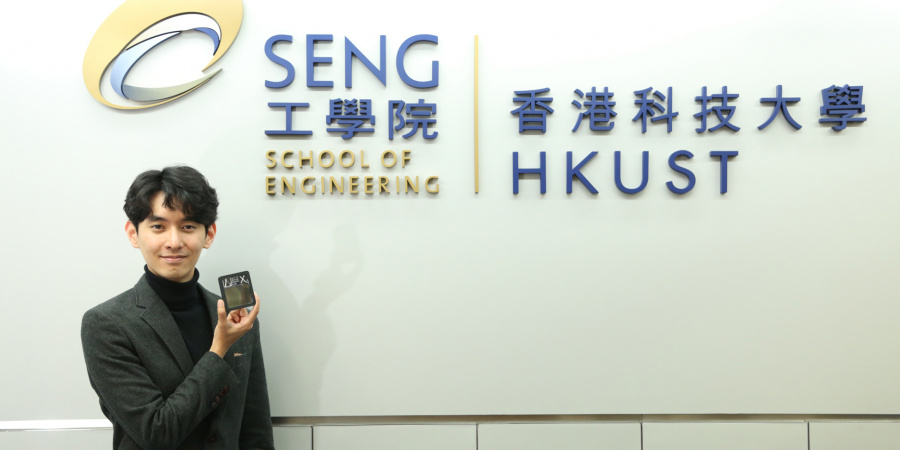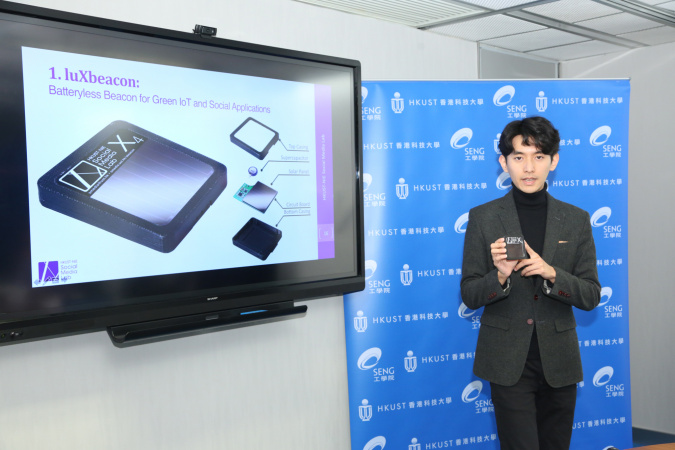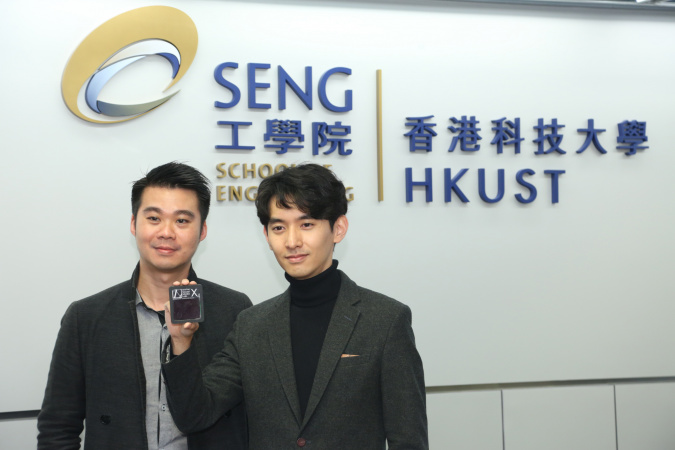HKUST Team Invents Revolutionary Batteryless Beacon for Future Social and IoT Applications – Saving Manpower and Protecting the Environment
Mr Kang Eun JEON, a doctorate student in HKUST-NIE Social Media Lab under the Department of Electronic and Computer Engineering of The Hong Kong University of Science and Technology (HKUST), has developed the “HKUST luXbeacon” – a Bluetooth Low Energy (BLE) Beacon that can harvest and store energy from both solar and indoor lighting, thereby capable of operating without batteries.
What are beacons?
Beacons are devices that enable the Internet of Things (IoT) to operate. A beacon can send out Bluetooth signals regularly that allow mobile phones to interact with the physical environment.
For instance, a beacon installed at a coffee shop can send out a welcoming message to a passing-by mobile phone user, and even attach a discount coupon to encourage patronage. Meanwhile, a fashion shop can attach a small beacon to each fashion item and when the customer approaches it, it will send information on that item to his mobile phone. Yet another example is that a smartphone can act as a car key to open the door with a beacon installed in the car.
Kang Eun said, “Beacons are fast becoming a key component in many coming social and IoT infrastructures. For instance, there are over 10,000 beacons recently installed at the Hong Kong International Airport for indoor navigation through traveller smartphones, although most people may not have noticed them yet.”
Benefits of batteryless beacons
Kang Eun said, “The majority of the BLE beacons in the world are battery-driven. As the batteries need to be regularly replaced or recharged, they require a lot of manpower for periodic maintenance, thus incurring a high labor cost. On the other hand, our invented beacon does not require any batteries – our novel hardware and firmware design can harvest energy from both solar light and indoor lighting, and store energy with latest super-capacitor technologies.
“When fully charged, the HKUST luXbeacon can run for 8 hours when broadcasting messages every second, and up to 32 hours when broadcasting messages every 10 seconds. It works for many beacon-based social IoT applications to maintain 24-hour operation without any built-in batteries.”
He continued, “The benefits of batteryless beacons are huge. If all the batteries used in all the beacons by 2018 are stacked up, they will reach a height of 22.5 km, or over 2.5 times the height of Mount Everest.
“The reduction in the use of batteries can contribute significantly to the prevention of global warming.”
Field tests
Another important benefit of HKUST’s batteryless BLE beacon is that it is practically maintenance free.
Kang Eun said that successful field tests have been conducted with several industrial collaborators in Bangkok for interactive outdoor media and smart city applications. Currently, the beacons used in the out-of-home media and transportation industries require a change of batteries every three to six months. As they are installed high up in the pillars, they need to arrange workers to climb up a ladder to change the batteries. This is not only labor intensive, but it also has a safety issue as road vehicles keep passing nearby.
HKUST luXbeacon is compact given its operational performance – 5 cm x 6 cm, and only 1 cm thick. It harvests and stores power very efficiently. Even on a normal cloudy day in Hong Kong, it can be fully recharged within 2 hours, and function at least 8 hours for a high performance beacon operation – that is, sending Bluetooth signals every 1 second.
HKUST’s contribution to the world
For the benefit of the international community, the Lab is ready to share this invention publicly by an open-hardware and open-source licensing process through the University, rather than to apply for patent which will restrict the use of this invention.
Kang Eun’s doctorate supervisor, Prof James SHE, Assistant Professor in the Department of Electronic and Computer Engineering (ECE), HKUST, said that the Lab will make the invention design, the source codes of the firmware, the circuit and component designs accessible through some open source platforms and policies, which means that anyone can download all the beacon and circuit designs used, chipset and component specifications as well as firmware developed by HKUST.
Prof She said, “HKUST ECE always wants to make a bigger impact to the world by our research, and we want this invention to be publicly affordable and accessible by many other inventors, engineers, developers, entrepreneurs, startups, and smaller companies. Our vision is that our HKUST luXbeacon will be adopted globally through crowd-sourced collaborations, and that the cost of products by our industrial collaborators incorporating our invention and technologies will become affordable like regular battery-driven beacons as a result of mass production and open-source and hardware initiative from our Lab.”



